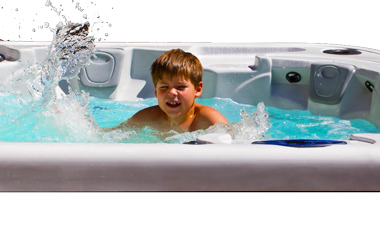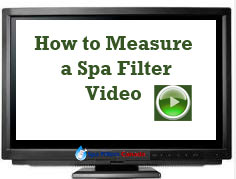Solving Hot Tub Water Problems – Bromine vs Chlorine
Caring for Your Hot Tub
Allowing friends and family into your hot tub carries a certain amount of responsibility with it to avoid unpleasant skin rashes and other unpleasant outcomes related to poorly maintained hot tub water.
Basically you need to make sure there is enough (but not too much) sanitizer, the pH is within 7.2-7.6 range and the water looks clear and not murky or full of foam. If the hot tub water has been the same for the last couple of months, it may just be time to change the water and start over.
Get bromine or chlorine online.
There are many exceptions to the sanitizer + pH monitoring regimen, but for most hot tub owners using either chlorine or bromine is the sanitizer of choice for effectively dealing with bacteria in hot water. Some exceptions may include salt water systems (which still generate bromine or chlorine from either bromine or chlorine salts), and newer natural spa treatments such as enzyme water treatments.
There are also additional accessories that may be able to help reduce the amount of chlorine or bromine needed in the water including ozonators or uv systems. Even with an installed ozonator that helps to kill bacteria when the water is filtering, a sanitizer is still required.
Chlorine or Bromine – Which Sanitizer is Best?
This is an age-old tossup that is different for different people and in different parts of the world. For example, in the Czech Republic, the use of Bromine is banned altogether, while in many other parts of Europe as well as the States and Canada, it is the sanitizer of choice due to its longer lasting properties in hot water.
Whenever chlorine is used in hot tubs, it is typically used in powder format or liquid form. Stabilized chlorine in tablet or granular form is the most popular for hot tub application. Tablets require a chemical dispenser or feeder while granular chlorine dissolves immediately in the water. Bromine is typically added in the form of bromine pucks that fit into a filter dispenser or floating dispenser. The optimum bromine level is 3–5 p.p.m.
Some people may have skin reactions to bromine or chlorine, so then the alternative is preferred. But other times it is not the chlorine or bromine that is causing the problem, but the bromamides and chloramides which are byproducts of the sanitizer that may be causing an issue. That goes back to unkept water being the culprit.
Bromine vs Chlorine
Atomic number 35, bromine, is a halogen and easily reacts with other elements. In nature, bromine is only found in compounds that are called bromides. Bromine and bromides are very powerful when it comes to destroying organic matter and also have a higher off-gassing temperature in hot water than does chlorine, so bromine lasts longer in hot water. At 58.8 degrees C, bromine becomes a gas. Bromine easily dissolves in water and forms hypobromous acid. Bromamines form in the water for disinfection ((NH2Br, NHBr2 and NHBr3) and pH influence the amount of compounds formed, so it is important to maintain proper pH so that bromine can do its job in a hot tub environment.
Did you know that bromine occurs naturally and is even prevalent in seawater (at about 65ppm) as both organic bromine substances and bromide salts are produced by many different types of sea organisms. For a more detailed explanation of the origins and chemical formulations of bromine, you can read this article. There is also a direct comparison of bromine vs chlorine for additional research.
pH Level
Keeping the pH of hot tub water in the range of 7.2 – 7.6 is important to keep sanitizer balanced and also to avoid the water becoming too acidic or too basic. Low pH (below about 7.2) can cause corrosion of spa equipment as it makes the water very acidic. High pH makes the water too basic and can cause scale to form and calcium carbonate to precipitate out of the water, causing slippery surfaces and cloudy water. Add pH plus if pH is too low and pH minus if pH is too high.
Measuring the water with test strips or a water test kit regularly will help monitor and keep the water quality in line.
Shock the Water
 Shocking the water does not involve throwing a hair dryer into the spa! This means adding non-chlorine shock treatment such as Sodium Monopersulfate based products. This is the way to get rid of body oils, debris and dirt from the spa water.
Shocking the water does not involve throwing a hair dryer into the spa! This means adding non-chlorine shock treatment such as Sodium Monopersulfate based products. This is the way to get rid of body oils, debris and dirt from the spa water.
This reactivates the sanitizer and helps reduce odor caused by excessive bound sanitizer. Chloramines or Bromamines are the compounds that create the bad smell and they need to be removed from the water regularly to stop them from accumulating. What actually kills bacteria are free bromine or free chlorine, not the combined chlorines or bromines. Combined chlorine for example is a combination with organic wastes and manifests itself as Hypochlorous Acid turned to Ammonia or a type of nitrogen.
So what is a hot tub owner to do if they don’t want to become a chemical engineer? Start with the basics, a tub of fresh water, a base amount of sanitizer and monitor/adjust pH. Shock weekly or as needed depending on spa use and keep sanitizer amount stable. Use an ozonator to reduce amount of sanitizer needed and enjoy clean water.
Alternatively, look into a natural hot tub water treatment with enzymes or other alternative spa treatment. Always make sure bacteria levels are under control and pH is balanced when using the hot tub. When in doubt, throw it out and start over, especially if the water is over a month old. Being able to go longer in between water changes will be related to the regimen you establish to monitor and correct hot tub water.
Foamy Water
If hot tub water is foaming excessively, then although you can add a product such as Foam Away or Foam Down to temporarily remove the problem, the deeper problem is that there are too many oils, lotions and detergents in the spa water. These are brought into the spa by residual detergent in hair and bathing suits as well as lotions and creams on the body.
Other than showering off before hot tub use, shocking the water regularly will help remove some of the product in the water. A coagulating agent will also help (such as the blue liquid that helps bind particles for removal by the spa filter). Also check calcium hardness levels to assure they are in line. If there are too many oils and organic materials in the water, then foaming can occur, or if the water is too soft that can happen as well.
Alkalinity
Sometimes alkalinity is referred to as the other metric to test for in addition to sanitizer level and pH level. The issue is that alkalinity moves along with pH. If alkalinity is in the ideal range, then pH is not thrown off as easily because alkalines act as a pH stabilizer. The ideal range for alkalinity is around 120 p.p.m. If alkalinity is very low, it can cause pH level to become unstable and even render sanitizers ineffective. If alkalinity is too high, then scale and murky water can form. The simpler condition to correct for is if alkalinity is too high as pH minus helps to bring down alkalinity.
Just when it seems the spa chemistry thing is under control, another variable depending on water districts is Calcium Hardness.
Calcium Hardness
This is a measurement of how hard the water is with an optimal range in the 160-280 p.p.m. If calcium hardness is very low, corrosion of jets and equipment can occur and if calcium hardness is too high, then scaling and cloudy water can occur. So be sure not to use a water softener to fill the spa.
Sidebar on Water Softners:
If your water is high in calcium, you may not sometimes want to use a water softener, but many hot tub manufacturers recommend against softeners. Yes mineral problems can be the result. Water softeners sometimes do not remove heavy metals/FE/iron..
In a pool, soft water tries to balance itself by leeching calcium directly from the pool walls. That is only an issue in gunite hot tubs but corrosion of metals can be a side effect. Metals in a spa include the flow-through heater element. In general it is best not to use more than 25% soft water in a spa. That being said, some manufacturers like Sundance actually recommend mixing in some soft water with hard water when needed.
Use a stain and scale inhibitor with hard water.
Some that use water softeners with well water complain of a chalky substance on the shell, so you will have all the needed chemicals anyways, best to avoid problems that may damage equipment. Or monitor and let us know if your results differ, we are always willing to update this section with real results.
Cloudy Water
If you read the above, then you will see there are many different reasons why the water in a spa can become cloudy. First be sure the filter cycles are set to an appropriate length and that the cartridge filter is clean. Sometimes it helps to increase the filtration cycle if it is programmed with only 1-2 hours per 12 hours of filtration. You may try 3-4 hours per 12 hours of filtration by letting each cycle filter longer.
If there are too many particulates in the water, or dirt and debris actually got into the water, then the water may need to be cleaned with a spa vac or at least allowed to filter for awhile. A high water hardness level or high pH can cause this condition as well.
Scale Forms on Acrylic Spa Shell
When a white powdery substance settles all across the spa shell and creates a slippery, slimy condition, this is scale formation caused by high pH, high alkalinity or high calcium. pH minus and/or a decalcifier will remedy this issue.
Scaling can be caused by several issues, but the first one to check is pH. If the pH is higher than 7.6, scaling can occur. Use pH minus/down to keep pH in the proper range and keep an eye on it with test strips.
If the water you are filling the spa with is already bad, then use a prefilter when filling spa.
Finally, to clear out guck from the lines, use AhhSome.
Links are below for these items as needed.
AhhSome: http://www.spafilters.ca/ahh-remove-gunk-hot-tub-plumbing/
PreFilter: Carbon based filter attaches to garden hose – see Max Clear Carbon Pre-Filter on Amazon Canada.
pH Reducer: http://amzn.to/1K4A8dJ
Smelly Water
If the water starts smelling like chemicals or worse, then chances are there is a lot of combined chlorine or combined bromine (in the form of chloramines or bromamines) in the water. A high level of organic contaminants mean that shocking the water may be the solution.
Whenever the spa water gets too far out of hand, a partial or complete drain may be necessary to start the regimen over. Then just make sure there is adequate sanitizer, check and balance pH regularly and shock the water every week or so. Keep the spa filter clean and your spa water should be crystal clear.

 |
| 
